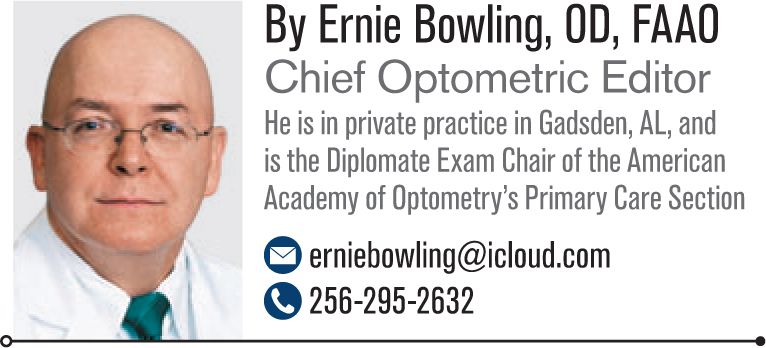What’s the value of eye care?
At that moment, I thought: What is eye care worth? I know we all have to make financial choices everyday, and we prioritize where we’ll spend our hard-earned dollars.

A teenager recently presented as a new patient to my office for a contact lens-related red eye. The condition resolved as you’d expect with a short course of topical antibiotic and steroids, but it would’ve undoubtedly cleared on its own had the young lady simply discontinued her contact lens wear for a short term, which was a clearly disappointing part of her treatment regimen.
At her follow-up visit, the eye was clear, and she was informed she could resume her daily wear of contact lenses. She seemed happy to do so, but the contact lenses she had worn into the office at the initial visit had been discarded, and she was without replacements. She asked if I could “give her a pair of contacts.”
Dr. Bowling: Is an optometric education cost-effective?
From her previous case history, I knew she had recently had an exam elsewhere. I asked if she had a copy of her contact lens prescription, which her grandmother replied was at home. I told her we’d be glad to fill it for her, or she could obtain them where she had her exam. Short of another complete exam, however, there was little I could do without an actual contact lens prescription.
“Oh, it’s not that,” said the grandmother, pausing to look up from her new iPhone 6. “It’s just that her dad is disabled, her mom is laid off from her job, I have back troubles, and there just ain’t enough to go around, you know?” I assured her that I understood, but again without a valid contact lens prescription there was little I could do. She and her grandmother exited the office seemingly more than a little irritated because I would not acquiesce to their request. Watching from the office window, I saw them drive off in a brand spanking new Yukon Denali (MSRP $63,7701), the temporary tag still adorning the rear window.
At that moment, I thought: What is eye care worth? I know we all have to make financial choices everyday, and we prioritize where we’ll spend our hard-earned dollars. We’ve all have seen surveys in which respondents state losing their vision is the worst possible life event,2 but when it comes to improving their sight with the use of spectacles and contact lenses, how much is a patient willing to spend? It’s a value judgment, and everyone has their own set of priorities. The signs of commoditization of eye care it seems are everywhere, from the devalued eye exams and products bombarding consumers (i.e., our patients) through media adverting and online offerings. So, is it any wonder a poorly-informed patient would think a contact lens is nothing more to them than a disposable razor instead of the medical device that it is?
Dr. Bowling: A full house at AAO
As with most patient care concerns, the largest hurdle here is patient education: constantly informing the patient of the value of the services we provide. While a national ad campaign would reach a larger audience, each one of us can make a significant impact one patient at a time. Yet the deeper issue might be how we as eyecare providers value our services. The old country eye doctor I once worked with had a saying: If you won’t value your service, no one else will. Considering the responsibility we assume in the care of our patients shouldn’t that value be high? So, I’m thinking a lot about what my services are worth, especially at the start of a new calendar year when we adjust our fee schedules. How about you? What do you think your service is worth? I’d like to hear your thoughts. Feel free to contact me at erniebowling@icloud.com.
References
1. GMC. 2015 Yukon Denali. Available at http://www.gmc.com/yukon-denali-premium-suv.html. Accessed 11/23/14.
2. PRWeb. Americans Fear Blindness More Than Heart Disease Survey Finds. Available at: http://www.prweb.com/releases/2010SurgeResearchInc /08/prweb4372854.htm. Accessed 11/24/2014.
Newsletter
Want more insights like this? Subscribe to Optometry Times and get clinical pearls and practice tips delivered straight to your inbox.